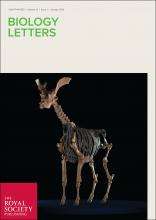Biology Letters
Biology Letters is a peer-reviewed, biological, scientific journal published by the Royal Society. It focuses on the rapid publication of short high quality research articles, reviews and opinion pieces across the biological sciences. Biology Letters has an average turnaround time of twenty four days from submission to a first decision.
 | |
| Discipline | Biology |
|---|---|
| Language | English |
| Edited by | David Beerling FRS |
| Publication details | |
| History | 2005-present |
| Publisher | Royal Society Publishing (United Kingdom) |
| Frequency | Monthly |
| Hybrid | |
| 3.323 (2018) | |
| Standard abbreviations | |
| ISO 4 | Biol. Lett. |
| Indexing | |
| ISSN | 1744-9561 (print) 1744-957X (web) |
| Links | |
The Editor-in-Chief is Professor David Beerling FRS (University of Sheffield[1]) who is supported by an international Editorial Board[2] of practising scientists.
Contents and themes
As well as the conventional, short research articles, Biology Letters has recently published Special Features and Mini Series.[3] While Special Features are a collection of up to 20 articles on a specific theme and published across multiple issues, Mini Series include up to six articles that are published in one issue. Examples of topics in these formats include ocean acidification[4], fossils[5], extinction[6], enhanced rock weathering[7] and the evolutionary ecology of species ranges.[8]
Content in the journal is regularly covered in the mainstream and social media. At the time of writing, a paper on Goffin’s cockatoos making tools to reach food [9] was featured in, The Guardian, New Scientist and The New York Times. Research describing the missing-link among dinosaurs [10] was reported by BBC News, CNN and The Times.
The 2010 a study of bumblebee behaviour by pupils from Blackawton Primary School[11][12] is the journal's most downloaded paper.
History
The journal was split off as a separate journal from the Proceedings of the Royal Society B: Biological Sciences in 2005 after having been published as a supplement.[13] Originally it was published quarterly, then bimonthly, and since 2013 it has been published monthly. The journal publishes short articles from across biology both online and in print.
Indexing
As of 2019 (2018 JCR index), Biology Letters has an impact factor of 3.323 and is ranked 17th in the Biology category.[14] The journal is indexed in Google Scholar, PubMed, Scopus and Web of Science.
External links
References
- "Professor David Beerling". University of Sheffield. Retrieved 2018-07-25.
- "Editorial Board". Retrieved 2017-09-18.
- "Special Features and Mini Series". Archived from the original on 2017-09-20. Retrieved 2017-09-18.
- "Ocean acidification". Retrieved 2017-09-18.
- "Putting fossils in trees: combining morphology, time, and molecules to estimate phylogenies and divergence times". Retrieved 2017-09-18.
- "Biology of extinction". Retrieved 2017-09-18.
- "Enhanced rock weathering". Archived from the original on 2017-09-20. Retrieved 2017-09-18.
- "Evolutionary ecology of species ranges". Archived from the original on 2017-09-20. Retrieved 2017-09-18.
- Auersperg, Alice M. I.; Borasinski, Stefan; Laumer, Isabelle; Kacelnik, Alex (2016). "Goffin's cockatoos make the same tool type from different materials". Biology Letters. 12 (11): 20160689. doi:10.1098/rsbl.2016.0689. PMC 5134049. PMID 27852942.
- Baron, Matthew G.; Barrett, Paul M. (2017). "A dinosaur missing-link? Chilesaurus and the early evolution of ornithischian dinosaurs". Biology Letters. 13 (8): 20170220. doi:10.1098/rsbl.2017.0220. PMC 5582101. PMID 28814574.
- "Primary school bee project published by Royal Society". BBC Online. 22 December 2010. Retrieved 22 December 2010.
- Blackawton Primary School; et al. (22 December 2010). "Blackawton bees — Biology Letters". Biology Letters. Royal Society. 7 (2): 168–172. doi:10.1098/rsbl.2010.1056. PMC 3061190. PMID 21177694.
- "Frequently asked questions | Biology Letters". rsbl.royalsocietypublishing.org. Retrieved 2016-03-03.
- "InCites™ [v2.25] - Sign In". jcr.incites.thomsonreuters.com. Retrieved 2018-07-25.